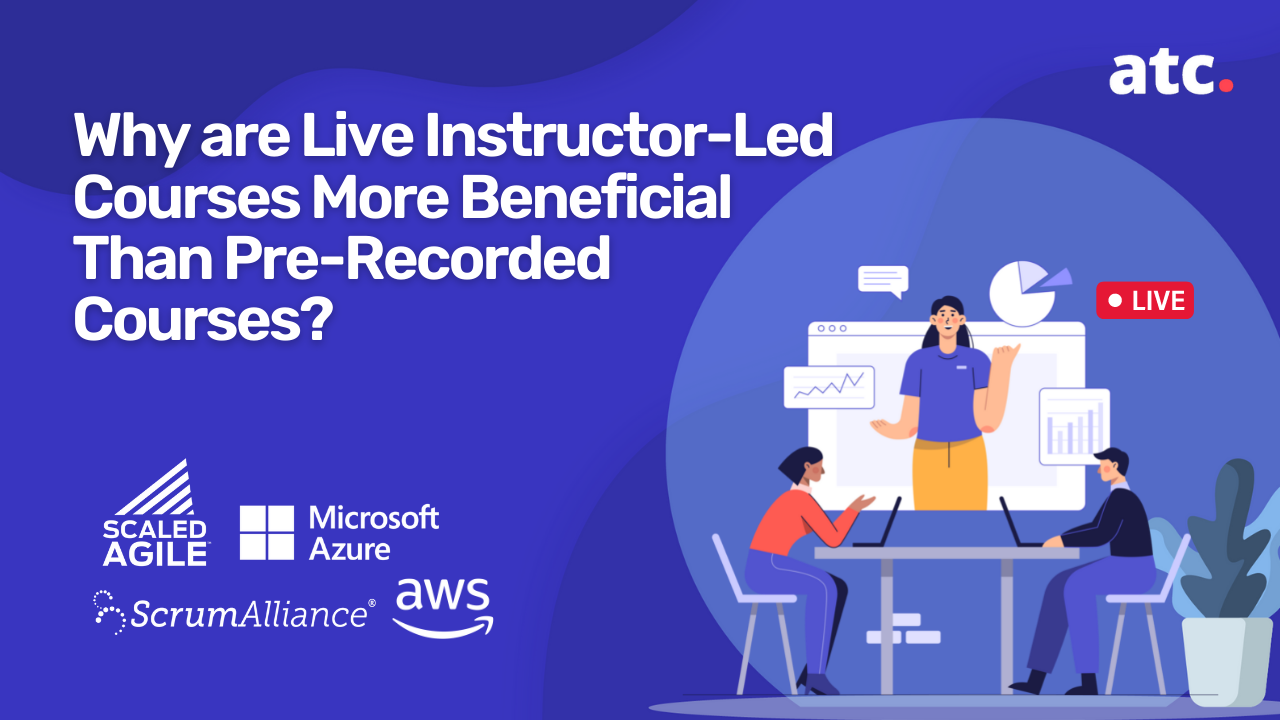Subscribe to the blog
The advent of advanced communication technology presents different options for consuming training, media, and learning. Arguably, practical training has experienced some of the greatest leaps: first through Virtual Reality (VR), followed by Augmented Reality (AR).
But there are practices throughout training and course programs that are still the same. They include pre-recorded (self-paced) courses and live instructor-led courses. Both types of courses are popular training methods today.
For new learners, both mediums and their potential benefits may lead to confusion over which method is the best. This further leads to countless internal debates among organizations regarding the best method to train and educate employees.
Here, we discuss the salient features that make instructor-led courses better compared to pre-recorded ones.
But before moving ahead, let’s look at why e-learning needs to be developed.
Why Develop E-Learning?
Businesses, organizations, and institutions are turning to e-learning courses due to being cost-effective and as effective as traditional training methods.
Developing an e-learning course structure is more expensive compared to setting up a classroom and coaching trainers, especially when interactive technology is used. However, the cost for delivering e-learning courses is cheaper, including technical support and web servers charges.
Moreover, online courses help save on costs and time associated with participants’ travel, lost job time, and instructor time. Online courses can also reach a wider audience, especially participants who may find it difficult to commute to or be present in a traditional classroom because of the following reasons:
- Geographical restrictions related to traveling and time
- Prior family and work commitments that make it difficult to attend classes at fixed venues, schedules, and dates
- Locations under various restrictive measures, such as during a conflict, after a conflict, or even during the lockdown, can seriously hamper mobility
- Religious or cultural beliefs can limit participation in a traditional classroom setting
- Shy and foreign language learners may face difficulties with real-time communication
Online courses also include the provision of feedback, bringing collaborative activities in the self-paced environment, and even personalizing the learning path based on learner requirements.
Enter Pre-Recorded Courses
Pre-recorded or self-paced courses have hit the market, and learning leaders could not have been happier.
Such courses provide a solution to a persistent problem: the cost that comes with instructor-led training. There is no more need to divert financial resources into hiring instructors, booking training venues, printing training material, etc.
The option of pre-recorded courses also makes it possible for participants to spend less time away from their jobs. However, pre-recorded courses come with some hard-to-hide flaws. For instance, they are not an ideal replacement for instructor-led courses. Self-paced courses, perhaps, are more useful as a tool in an organization’s development and learning kit and should be used sparingly.
The Limitations of Pre-Recorded Courses
Company leaders outside the field of teaching are piling on the pressure to ensure that pre-recorded courses work. To them, these courses are a cost-effective solution, despite the advantages of virtual instructor-led courses such as increased learning retention and performance as well as better engagement and collaboration.
Virtual classes make pre-recorded courses a viable solution. They include different techniques such as gamification, mobile learning, and video-based classes. However, these new options of attending classes do not guarantee that participants will retain their training any better.
Notably, pre-recorded courses have a few limitations:
- The lifespan of most digital content is short. Thus, it becomes outdated fast in the absence of frequent refreshing. Keeping up with changes is a resource-intensive challenge.
- Remote access to the course is only viable with the right tools and infrastructure. Participants require the latest network-optimized laptops, iPads, and other mobile devices. Access to a strong internet connection is critical, as is technical motivation and aptitude.
- While bells and whistles introduced into a pre-recorded course can improve engagement, they do not guarantee that participants will retain knowledge better. Also, spot-testing only measures the learner’s capability to memorize and not how they can apply the newly acquired knowledge in the workplace.
- Pre-recorded courses are better suited to simple subject matters and not for advanced or complex topics.
- Although technology is evolving, the learning principles applicable to adults remain the same. An adult finds face-to-face interaction, collaboration with like-minded individuals, and real-time feedback the best ways to retain new knowledge and improve the chances of using new skills on the job.
Many developers prefer allocating 50 to 80 percent of the course towards instructor-led interaction. However, despite the technical nature of their duties, employees do not prefer pre-recorded course options.
On-site or online instructor-led training is the most preferred method by technical employees. Therefore, it’s safe to say that instructor-led training will not die out anytime soon, despite its serious limitations. Although a pre-recorded course has its place, the challenge is in identifying that very place. The virtual alternative comes in to create an effective solution that combines it with pre-recorded sessions.
The Human Support Angle
Why are virtual instructor-led courses important in the technical field?
There is an important training component that even the most technologically advanced pre-recorded courses cannot provide—the human element, in the form of fellow participants and instructors. Without the latter, participants in pre-recorded courses simply copy what’s on the screen. Metaphorically speaking, participants are not getting their hands dirty. They do not learn to make connections with others and get opportunities to apply what they’ve learned in real-world scenarios. Participants also don’t get a chance to discuss with their peers, who would have understood the material differently. Trying out new things or getting a chance to be innovative while learning is also not possible in the pre-recorded format.
To a certain extent, pre-recorded courses are good because the information flow is one-sided. In a live, instructor-led course, participants can make mistakes, identify them, and even get professional help.
According to some learning experts, pre-recorded courses are not very different from watching movies as they are not interactive in nature, like in a real or virtual classroom. From the perspective of the impact of learning, pre-recorded courses just provide information.
The complexity component of a majority of technical subjects needs to have a give-and-take relationship between an instructor and learners. This ensures knowledge retention, absorption, and real-world application. Technical languages such as coding require experienced instructors who are capable of answering questions immediately with examples related to the subject matter and will interact with the participants after the session.
The Cost Factor
Admittedly, the right infrastructure can make the delivery of pre-recorded courses easy, making it scalable and an ideal training solution for companies with limited budgets; however, this factor is relative.
No matter how much companies intend to spend on training, there are questions businesses should ask themselves: Are we getting our money’s worth? Are the employees and the business benefiting from the training structure?
In many pre-recorded course situations, the answer to these questions would be no.
Some organizations choose to provide rewards such as an incentive or bundle prizes to encourage participation. While not as much as the training, the rewards cost money. If employees are not motivated to learn or are only interested in prize bundles, they won’t be fully engaged. As a result, they are inattentive and do not act on what they learn.
In financial terms, engagement is critical. Otherwise, the company will spend on courses, time, and delivery with little return on the investment to show.
Instructor-led courses encourage learner engagement. Instructors can see what piques the interest of learners, identify potential problems, questions, or even concerns. Participants can engage with others, build on their knowledge, and share information. The included assessments also help measure the effectiveness of the course.
Best Training for the Technical Audience
There is no one-size-fits-all training solution for many learners. For this reason, learning experts prefer offering a blended teaching approach over pre-recorded training on its own. However, technical talent with technical mastery can easily manage self-learning via pre-recorded courses.
The learner gets to progress at their own pace, review, and speed up depending on their expertise. However, the challenge is if the course is not interesting or connected to the participants’ immediate job positions. You depend on internal motivation for participants to want to make progress and complete learning assignments.
Even self-motivated learners are easily distracted, especially considering the modern busy and noisy environment. Technical talent at the lower cadres is most likely to benefit from the structured learning environment, available support, and peer group in instructor-led courses.
The best course materials infuse an element of self-paced discovery using methods such as online learning and the ability to engage with other participants. This usually happens in the lab or classroom, where the sense of community is critical for technical talent.
Learning managers must occupy the learners’ time with courses that help them become effective on the job. With that in mind, do not rush to the first training solution and celebrate that your employees are learning. Make sure that your training provider and partners they work with prepare in advance to set-top performance goals and not just learning objectives.
To ensure they meet course goals, the training manager should refrain from searching for course solutions as a subsidiary decision. Achieving organizational ROI goals goes beyond pre-recorded versus instructor-led courses. Choose the training course that meets the current and future requirements of your talent.
A blended course that includes an experiential component is critical in technical subjects. Course participants can safely practice what they are learning in an environment that’s adapted to accept and correct mistakes.
How to Transition to Virtual Instructor-Led Courses
Norma Talmadge was a big star during the silent movie era. For over a decade, she was an IT girl. But after the movie industry transitioned to talking movies, Norma’s popularity plummeted—along with other Hollywood stars.
The number one reason was that they failed to transition from the old medium to a modern medium.
Silent films and talking films both belong to the movie industry. The same way pre-recorded courses, in-person courses, and virtual instructor-led courses are pieces of the training industry. However, each niche requires distinct skill sets.
Trends in the learning and development industry now offer more virtual courses, so professionals now have to gain skills to continue in the field. Real-life situations are driving these changes.
Consider this, one day participants and trainers were busy making car rental, hotel, and airline reservations for courses. The next day, trainers are busy canceling reservations and dealing with empty calendars, reluctantly looking towards virtual instructor-led training.
What is the Verdict?
Pre-recorded courses are suitable in certain situations, especially where you are sharing uncomplicated and not customized information. However, there are limitations. Often, the blended course is a better way to develop tailored content to meet the organization’s goals or seal identified knowledge gaps.
A virtual instructor-led course is an ideal solution where you require lab experience and interaction between the instructor and peers for a better teaching experience. Participants are in a better position to expand on the course content, ask questions, and even share detailed information. The instructor in such a class can also gauge whether the content is sufficient and if trainees get the right information to improve job performance.




